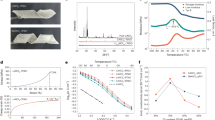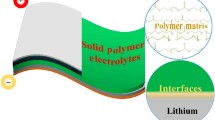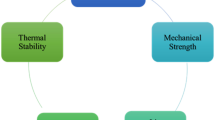Abstract
EFFORTS to develop a high-voltage, lightweight rechargeable battery for electrically powered vehicles have focused on batteries based on solid electrolytes, which offer good mechanical strength, easy packaging and high energy densities. An important objective is to identify an electrolyte with the desired combination of mechanical properties, electrical conductivity and stability against powerfully oxidizing and reducing electrodes (lithium is preferred for the anode). Among the most promising materials are rubbery 'salt-in-polymer' electrolytes and highly conducting but brittle superionic glass electrolytes. In the latter category are salts with good lithium-ion conductivity, which are compatible with lithium-anode systems. Here we describe new ionic conductors — 'polymer-in-salt' materials — in which lithium salts are mixed with small quantities of the polymers polypropylene oxide and polyethylene oxide. These materials have glass transitions low enough to remain rubbery at room temperature while preserving good lithium-ion conductivities and high electrochemical stability.
Similar content being viewed by others
References
Armand, M. B., Chabagno, J. M. & Duclot, M. J. in Fast Ion Transport in Solids (eds Vashista, P., Mundy, J. N. & Shenoy, G. K.) 131–136 (Elsevier, Amsterdam, 1979).
Shriver, D. F. et al. Solid State Ionics 5, 83–91 (1981).
Cowie, J. M. G. & Cree, S. H. A. Rev. Phys. Chem. 40, 85–113 (1989).
Skaarup, S., West, K., Yde-Andersen, S. & Koksbang, R. in Recent Advances in Fast Ion Conducting Materials and Devices (eds Chowdari, B. V. R., Liu, Q.-G., & Chen, L Q.) 83–95 (World Scientific, Singapore, 1990); J. Power Sources 32, 175–185 (1990).
Huq, R., Koksbang, R., Tønder, P. E. & Farrington, G. C. in Recent Advances in Fast Ion Conductivity Materials and Devices (eds Chowdan B. V. R., Liu, Q.-G. & Chen, L. Q.) 63–71 (World Scientific, Singapore, 1990).
Steele, B. C. H. Mat. Sci. & Eng. B. Solid State 13, 79–87 (1992).
McLin, M. C. & Angell, C. A. Solid State Ionics 53/56, 1027–1036 (1992); J. Phys. Chem. 95, 9464–9469 (1991)
Angell, C. A. Solid State Ionics 9/10, 3–16 (1983).
Angell, C. A. Ann. Rev. Phys. Chem. 43, 693–717 (1992).
Berry, G. C. & Fox, T. G. Fortschr. Hochpolym-Forsch 5(3), 262–357 (1968).
Sundheim, B. R. in Fused Salts (McGraw Hill, New York, 1964); J. Phys. Chem. 60, 1381–1383 (1956).
Fan, J., Marzke, R. F. & Angell, C. A. Symp. Mat. Res. Soc. 1993 (in press).
Tatsumisago, M., Angell, C. A. & Martin, S. W. J. chem. Phys. 97, 6968–6974 (1992).
Mercier, R., Malugani, J.-P., Fays, B. & Robert, G. Solid State Ionics 5, 663–666 (1981).
Webber, A. J. electrochem. Soc. 138(9), 2586–2590 (1991).
Auburn, J. J., French, K. W., Lieberman, S. I., Shah, V. K. & Heller, A. J. electrochem. Soc. 120, 1614–1619 (1973).
Author information
Authors and Affiliations
Rights and permissions
About this article
Cite this article
Angell, C., Liu, C. & Sanchez, E. Rubbery solid electrolytes with dominant cationic transport and high ambient conductivity. Nature 362, 137–139 (1993). https://doi.org/10.1038/362137a0
Received:
Accepted:
Issue Date:
DOI: https://doi.org/10.1038/362137a0
- Springer Nature Limited
This article is cited by
-
The Promise of 3D Printed Solid Polymer Electrolytes for Developing Sustainable Batteries: A Techno-Commercial Perspective
International Journal of Precision Engineering and Manufacturing-Green Technology (2024)
-
A reflection on polymer electrolytes for solid-state lithium metal batteries
Nature Communications (2023)
-
High-conducting, economical, and flexible polymer-in-salt electrolytes (PISEs) suitable for energy devices: a reality due to glutaraldehyde crosslinked starch as host
Journal of Solid State Electrochemistry (2023)
-
Lithium polymer electrolytes for novel batteries application: the review perspective
Applied Physics A (2023)
-
Exploration of organic superionic glassy conductors by process and materials informatics with lossless graph database
npj Computational Materials (2022)





